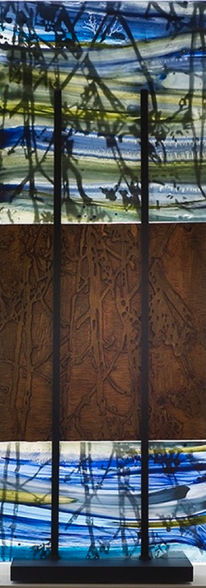The Surface of Things, Chasing Light

Alberta Craft Council Discovery Gallery 2018
The slightest movement, breath, or touch causes a surface change in an instant; nothing is fixed, stable or whole. Akin to the concept of memory, the works fade, fragment, intertwine and evolve into a layered recollection of time and environment.

Beautiful twenty six page full colour catalog available.
Essay by distinguished writer and curator
Mary-Beth Laviolette.
Design by Halkier + Dutton Design,
Photography by Bluefish Studios, Mark Dutton, and Brenda Malkinson.


Take one kayak, one large lake in central Alberta, and the daily observation of its watery shallows, and sensed almost immediately is the role of place and passion in The Surface of Things. The place is Buffalo Lake; the passion is Brenda Malkinson’s: immersed, it seems to me, in an existential quest to engage with the very things connecting her to this beloved environment.
In Malkinson’s art, there are no cabins or boats or anything implying a human presence. There is only lake water and the inconsequential things she observes on its surface and below.
In one woodblock print dated “October nineteenth 7:51 pm, recalled is the bluish reflection of floating twigs, and in yellow and white - the slender presence of minnows swimming by. As for the art work’s date, it refers to the time when the artist, now back in her studio, rendered a sketch. Thus, rather than being documentary in intention, at play In The Surface of Things is an intuitive strategy repeated in twenty-one distinct monoprints. Similarities connect the prints as a body of work but intriguingly, so do their differences.
In addition to these prints, Brenda Malkinson is also a painter who in place of canvas employs flat square plates of vitrified glass. The pigments she uses are rare: developed in sixteenth century France when stain glass adorned some of its greatest architecture. They neither fade nor scratch and in the case of the three sculptures created for The Surface of Things, the lake as an organic entity is also their subject.
There are washes of blue, grey and green to suggest lake water while earthier tones allude to sandy shallow bottoms or a shoreline of foliage. Either way, there is nothing very literal replicated on these transparent glass sheets. What they represent instead is the artist’s impression or response to the environment around her. In this sense, The Surface of Things recalls the Impressionist Claude Monet and his own particular fascination with water lilies at his Giverny home in late19thcentury France.
Combined with the glass components are flat square blocks of wood - their surfaces carved and cut-away to suggest phenomena like the ripple of water . As woodblocks, they are used to print an impression on paper. But in this exhibition three of the blocks are displayed as part of the sculptures; artistic objects in their own right because of what their carved tactile surfaces convey.
The three sculptures are totemic in design; each featuring a woodblock placed between two upright plates of the painted glass. Braced discreetly by slender metal posts, these are freestanding artworks bring another dimension to this ongoing project. Light moves easily through them. And so does the sense of there being a timeless quality to the artist’s concept.
The timelessness is reflected also in the display of the twenty-one of woodblock prints. Organized on a wall in a grid formation with four prints per vertical row, quoted is mid-20thcentury art such as Minimalism and Color Field painting. Here the grid is used to create a large fluid and visually tactile composition. It evokes the spare elegance of Minimal art and the ambitions of Color Field to spread beyond the composition itself. Similar in fact to the watery reality of a lake. Consider it a living organism with a flat surface and a sensitive character.
At its most primal Brenda Malkinson’s calling was to render by sketch the mutations and interplay of wind and light on water. All done by memory and evoking metaphorically, for me at least, the transcendental and the spiritual. A measure of not only what she perceived but also experienced as a kayaker and a swimmer. Thus, there are moments of absolute stillness in the art on display and moments of moving through water as Brenda chased the light and explored what it meant to be truly on the ‘surface’ of things.
Mary-Beth Laviolette, independent art curator and writer
July, 2018







